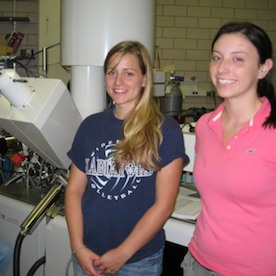Pontarelli’s chemistry research leads to medical fellowship
In her first two summers at Cornell, Tina Pontarelli studied polyoxometalates in the research lab of chemistry professor Craig Teague. She says the skills she learned helped her land a Cornell Fellowship for the summer of 2008 at the Baylor College of Medicine.

“The most meaningful aspect of my Cornell summer research was getting the opportunity to search through primary literature and use that as a basis to practice the scientific method, design my own experiments, and then report the results,” she says. “I also had the opportunity to use instruments that aren’t used in chemistry classes on a regular basis, such as infrared spectrometers, and I even had the opportunity to travel to different institutions to use other instruments.”
In Teague’s lab, Pontarelli studied the interaction of a particular polyoxometalate with alumina and silica surfaces. Her research employed the use of atomic force microscopy, x-ray photoelectron spectroscopy, and infrared spectroscopy.
Meanwhile, other students, including Megan Michalski and Brittany Szczepanik in 2007, performed related studies. The long-term hope is that this class of materials may someday be used to compact and store nuclear waste, but for now the research focuses on understanding fundamental properties and behavior.
The fruits of their efforts were displayed during the 2008 Cornell Student Symposium through both oral and poster presentations.
“Getting the opportunity to share the summer’s work with the Cornell community was a rewarding experience,” Pontarelli says. “It is satisfying to be able to report the results of a summer’s work and it is also interesting to see all the other research opportunities Cornell has to offer.”



